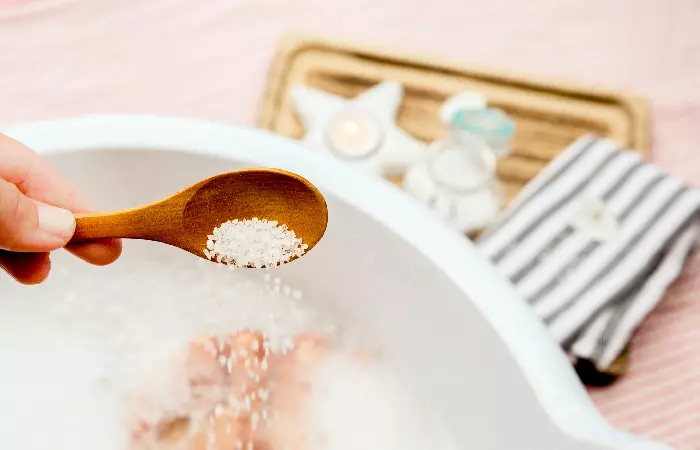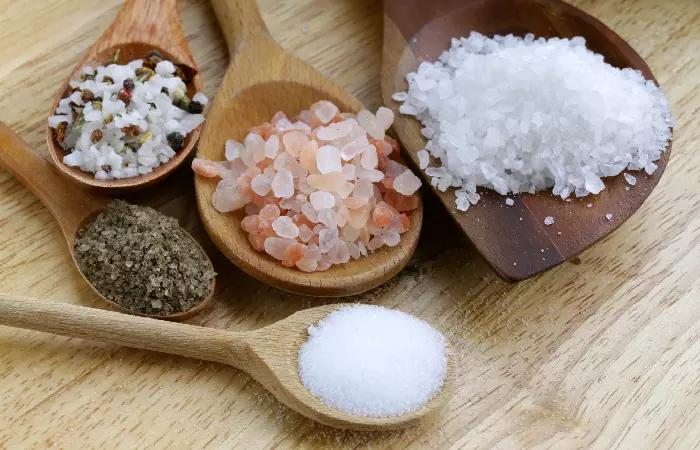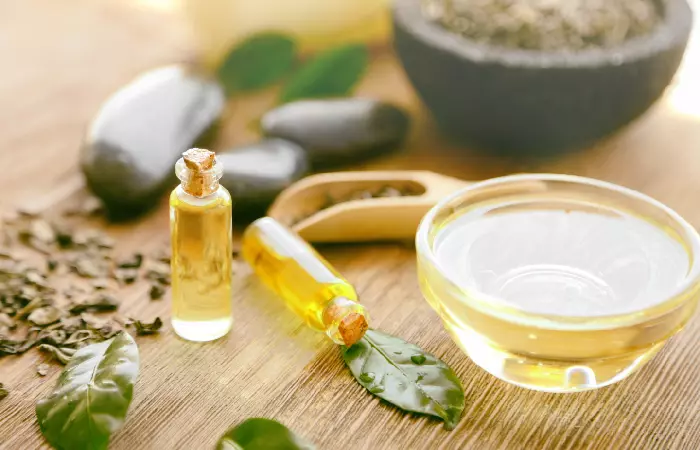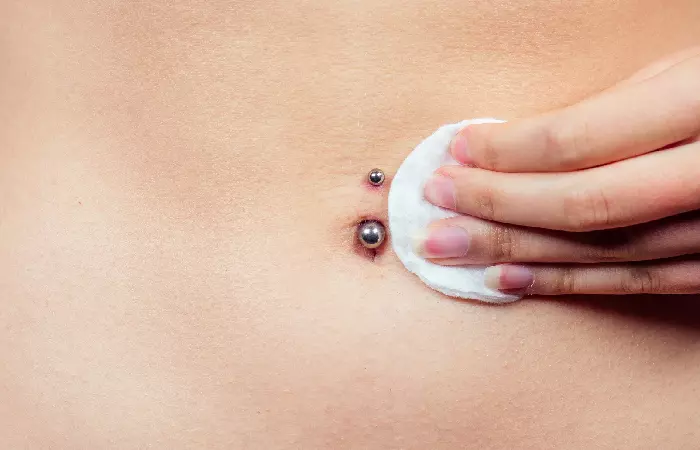What Is A Sea Salt Soak?
Evaporated seawater leaves behind crystals known as sea salt. You can mix sea salt with warm water to make a special soak for a body part, like the feet or hands. Often people use a sea salt soak to help with sore muscles or skin conditions. Saltwater baths are often considered a noninvasive, low-cost, and effective treatment to help reduce pain and signs of skin infection (1). It is one of the most common piercer and doctor recommended aftercare solutions to speed up the healing of piercings. It is said to cleanse the pierced skin and provide additional benefits that aid the skin’s healing process. But can a sea salt soak be used for all types of piercings? Check out the next section to find out!
Does Sea Salt Work For Every Type Of Piercing?
Yes, sea salt can be beneficial for various types of piercings. While the body is primarily responsible for healing, a saline solution made with sea salt may help maintain cleanliness around the piercing area. Normal sterile saline solutions are often regarded as non-toxic and do not damage the healing tissue (2). However, certain piercings, such as facial piercings, may pose challenges in soaking entirely due to their position. For example, when attempting to soak an eyebrow piercing in a cup of water, the positioning required to keep the head submerged may lead to water entering the eyes, making it impractical or uncomfortable to achieve full soaking without compromising eye safety. In such instances, alternative methods like using spray products or applying a hot compress with a towel soaked in the solution for 5-10 minutes are recommended. Also, you can saturate the area and allow it to air dry. These techniques ensure proper care, even for piercings that are difficult to soak completely. Now that we have covered how to use sea salt for different piercings, learn about the types of sea salts available on the market and which ones to use. Read on to find that out.
What Kind Of Sea Salt Is Safe For Piercings?
When considering sea salt for piercings, it is best to opt for non-iodized sea salt or sterile saline solution. Natural, unprocessed sea salt can be a suitable option, provided it is non-iodized and free from additives or fragrances. Nevertheless, it is essential to ensure that the sea salt is properly dissolved in sterile water to avoid any abrasive particles that could irritate the piercing site. While options like fine-grain sea salt and dead sea salt may seem appealing due to their mineral content, they are not the best choice for piercings. Fine-grain sea salt may not dissolve completely in water and the leftover abrasive particles can irritate the piercing site. Mineral-rich dead sea salt can be too harsh for fresh piercings due to its high concentration of minerals that may cause irritation or excessive dryness. However, as always, it is recommended to consult with a piercer or medical professional for personalized advice on piercing aftercare. They can also provide guidance on the appropriate use of sea salt soaks that have been shown to offer various benefits for promoting skin health and wound healing. Check out the next section to learn its benefits in detail.
6 Benefits Of Sea Salt For Piercings
Sea salt is readily available and affordable, making it a cost-effective option for piercing aftercare compared to specialized products. According to anecdotal evidence, sea salt is known for its natural cleansing properties. When dissolved in warm water, it creates a gentle saline solution that helps to cleanse the piercing site without harsh chemicals (2). Natural sea salt contains trace minerals such as magnesium, calcium, and potassium, that help nourish the skin and promote overall skin health (3). Sea salt-based solutions promote healing in wounds, including piercings (4). They keep the piercing site clean and free from irritation, promoting faster healing. Purified ocean salt water may help prevent or treat inflammation (5). Sea salt soaks have antimicrobial properties that help reduce the risk of infection by lowering bacteria levels, making it easier for the body to fight infections (6). They clean the piercing by tightening the skin and removing debris, preventing infections. According to anecdotal evidence, sea salt soaks combined with aspirin may help treat keloid scars. Hyokii, a lifestyle blogger, developed keloid scars due to poor piercing aftercare. However, applying this mixture helped her treat the issue. She writes, “Keloids are very common with surface piercings and my cousin’s wife got one while hers was healing. She told me to crush some aspirin and make a paste with a few drops of water. Keep it on the piercing overnight and wash it off in the morning. It started working and my keloid went down slowly. I also heard that some people add some sea salt in the mixture, so I did that and it went down significantly (i)!” Additionally, sea salt is a versatile option that allows for flexibility in piercing aftercare routines. Continue reading to learn how to use sea salt soak in different ways.
4 Different WaysTo Do A Sea Salt Soak
You can use sea salt in various forms, such as saline soaks, sprays, or paste. Here are a few ways.
1. Sea Salt Soak For Piercings
Here is how you can clean your piercing jewelry with a sea salt soak. Ingredients
1 cup of warm water ¼ teaspoon of sea salt Cup or bowl Clean paper towels (if needed)
Procedure Hyokii also shared how she incorporated sea salt soak in her aftercare routine post getting a belly button piercing. She writes, “I used to do sea salt soaks twice a day and clean it with original Neutrogena every day in the shower (i).”
2. Sea Salt Spray For Piercings
Ingredients
1 cup of water ¼ teaspoon sea salt Sterile spray bottle
Procedure
3. Sea Salt Paste For Piercings
Ingredients
1-2 teaspoons of water ¼ teaspoon sea salt A small container/bowl
Procedure
4. Tea Tree Oil And Sea Salt For Piercings
Ingredients
¼ teaspoon sea salt 2-3 drops of tea tree oil 1 cup of water Clean paper towel
Procedure An important thing to remember is to follow the steps very carefully as sometimes leaving the salt for more than the recommended period may cause irritation. Keep reading to find out more.
How Long Do You Leave Sea Salt On A Piercing?
Sea salt soaks for piercings are typically left on the healing skin for no more than 5 minutes at a time unless recommended otherwise. It is important to not over-soak the piercing, as excessive exposure to saltwater can potentially dry out the skin or cause irritation. After the recommended time, the piercing area should be gently rinsed with fresh water to remove any remaining salt residue. It is essential to follow the specific aftercare instructions provided by your piercer or medical professional for best results. Using homemade saline solutions for piercings may help promote healing and prevent skin infections. Besides these sea salt mixtures, there are sterile saline solutions that you can use at home. Though made with salt, they are not the same as sea salt soaks. Keep reading to know the difference between the two.
Saline Solution Vs. Sea Salt Soak For Piercings
A saline solution and sea salt soak serve as two distinct options for piercing aftercare.
Saline solutions, typically a mixture of purified water and pharmaceutical-grade salt, are known for their sterile nature, mirroring the salt concentration and pH of bodily fluids. Packaged in aerosol cans, they ensure sterility throughout use and contain only essential ingredients. In contrast, sea salt soaks involve mixing distilled water with sea salt, potentially introducing contaminants from the environment. While sea salt may offer additional minerals, its preparation lacks guaranteed sterility, increasing the risk of contamination. Also, sea salt soaks may not match the pH levels of the human body, leading to potential irritation. With the accessibility and affordability of sterile saline solution, sea salt soaks have also become less common in professional piercing aftercare recommendations (9).
How long does it take for sea salt soak to heal the piercing? The time it takes for a sea salt soak to heal a piercing can vary depending on several factors, including the type of piercing, individual healing process, and how well the aftercare routine is followed. Generally, piercings can take anywhere from a few weeks to several months to fully heal. What can I use instead of sea salt for piercings? Alternatives to sea salt for piercings include sterile saline solution, over-the-counter piercing aftercare products, or solutions containing benzalkonium chloride or tea tree oil. However, ensure you use it with caution and follow your piercer’s instructions properly. Is pink Himalayan salt good for piercings? Pink Himalayan salt is not typically recommended for piercings. It is not as finely ground as regular sea salt and may not dissolve as easily in water. This can lead to abrasive particles irritating the piercing site. Can I use regular table salt instead of sea salt for my piercing? It is not recommended to use regular table salt for piercings. Table salt often contains additives like iodine and anti-caking agents that can be irritating to the piercing and interfere with the healing process. Is coarse sea salt okay for piercings? Coarse sea salt is generally not recommended for piercings. The texture of coarse sea salt can be abrasive and may irritate the piercing site. Sea salt soaks play a pivotal role in ensuring the successful healing of piercings. Wondering how to incorporate sea salt soaks into your aftercare routine? Watch this informative video to learn more about using sea salt soak for piercings. (i) Belly Button Piercing Update https://babogongjuu.blogspot.com/2014/06/belly-button-piercing-update-june-2014.html









